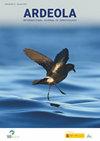两种分析方法提取禽蛋壳色素的比较研究
IF 1.2
4区 生物学
Q2 ORNITHOLOGY
引用次数: 0
摘要
从禽蛋壳中提取色素主要有两种方法。有些使用强酸(如硫酸、盐酸或甲酸),可以定量测定色素浓度,但会破坏样品。另外,也有使用较弱酸(如乙酸)的方法,样品不会被破坏,尽管色素浓度可能无法定量,仅检测其存在。在某些情况下,可能需要对已经检测到的样品中的色素进行定量。在这里,我们评估了使用强酸从蛋壳中提取的色素的数量是否受到先前用弱酸处理蛋壳的影响。为此,我们使用了肯特鸻(Charadrius alexandrinus)和国内日本鹌鹑(Coturnix japonica)的蛋壳,并用两种酸(先用弱酸,然后用强酸)或只用强酸处理过等量的单个蛋壳。原卟啉和胆绿素(主要的蛋壳色素)的提取量在弱酸处理后用强酸处理时较低。然而,使用这两种方法提取的色素数量之间存在显著的正相关关系,这表明用于确定色素存在的蛋壳样品可能仍然可用强酸来量化色素浓度。-Gomez, J., Ramo, C., Canales, J.A., Garcia, i.m., Castro, M., Perez-Hurtado, A.和Amat, J.A.(2020)。两种分析方法对禽蛋壳色素提取的比较评价。本文章由计算机程序翻译,如有差异,请以英文原文为准。
A Comparative Assessment of Pigment Extraction from Avian Eggshells Using Two Analytical Protocols
There are two main methods to extract pigments from avian eggshells. There are those using strong acids (e.g. sulphuric, hydrochloric or formic), that allow for a quantification of pigment concentrations but with which samples are destroyed. Alternatively, there are methods employing weaker acids (e.g. acetic), with which samples are not destroyed, although pigment concentrations may not be quantified and only their presence is detected. In some cases, there may be a need to quantify pigments in samples in which the pigments have already been detected. Here, we assess whether the quantity of pigments extracted from eggshells using a strong acid is affected by previous treatment of eggshells with a weak acid. For this, we used eggshells of Kentish Plovers Charadrius alexandrinus and domestic Japanese Quails Coturnix japonica, and aliquots of individual eggshells treated either with both acids (first applying a weak acid and then a strong acid) or only with the strong acid. Quantities of extracted protoporphyrin and biliverdin (the main eggshell pigments) were lower when using a strong acid after application of a weak acid. However, there were significant positive correlations between the quantities of pigments extracted using the two methods, suggesting that eggshell samples used to determine pigment presence may still be usable to quantify pigment concentrations using a strong acid.—Gomez, J., Ramo, C., Canales, J.A., Garcia, I.M., Castro, M., Perez-Hurtado, A. & Amat, J.A. (2020). A comparative assessment of pigment extraction from avian eggshells using two analytical protocols.
求助全文
通过发布文献求助,成功后即可免费获取论文全文。
去求助
来源期刊
CiteScore
2.30
自引率
6.20%
发文量
16
审稿时长
>12 weeks
期刊介绍:
Ardeola: International Journal of Ornithology is the scientific journal of SEO/BirdLife, the Spanish Ornithological Society. The journal had a regional focus when it was first published, in 1954. Since then, and particular during the past two decades, the journal has expanded its thematic and geographical scope. It is now a fully international forum for research on all aspects of ornithology. We thus welcome studies within the fields of basic biology, ecology, behaviour, conservation and biogeography, especially those arising from hypothesis-based research. Although we have a long publication history of Mediterranean and Neotropical studies, we accept papers on investigations worldwide.
Each volume of Ardeola has two parts, published annually in January and July. The main body of each issue comprises full-length original articles (Papersand Review articles) and shorter notes on methodology or stimulating findings (Short Communications). The publication language is English, with summaries, figure legends and table captions also in Spanish. Ardeolaalso publishes critical Book Reviewsand PhD-Dissertation Summaries; summarising ornithological theses defended in Spain. Finally there are two Spanish-language sections, Ornithological News; summarising significant recent observations of birds in Spain, and Observations of Rare Birds in Spain, the annual reports of the Spanish Rarities Committee.

 求助内容:
求助内容: 应助结果提醒方式:
应助结果提醒方式:


